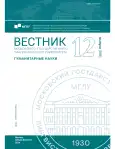EXPRESSION OF EMPATHY AS A MEANS OF CONVEYING THE AUTHOR’S COMMUNICATIVE INTENTION
- Authors: Bogomolova A.V.1
-
Affiliations:
- Irkutsk State University
- Issue: No 12(893) (2024)
- Pages: 9-15
- Section: Linguistics
- URL: https://journal-vniispk.ru/2542-2197/article/view/291690
- ID: 291690
Cite item
Full Text
Abstract
The article discusses the use of empathy in conveying the author’s communicative intention on the example of the author’s translation of Tugdual de Gouvello’s autobiographical work "Enfant Fa’a’amu." In order to achieve the aforementioned goal, a number of methods were employed, including the method of contextual analysis, the method of comparative analysis and the method of solid sampling. It can be concluded that empathy allows the translator to gain insight into the author’s inner world, thereby enabling the determination of the communicative intention and the facilitation of the reader’s comprehension of the hidden meanings and the author’s experiences. It can be postulated that in order to achieve a communicatively equivalent translation, the translator needs to be creative.
About the authors
Alexandra Vladimirovna Bogomolova
Irkutsk State University
Author for correspondence.
Email: bogomolova_av96@mail.ru
Senior lecturer at the Department of Translation and Translation Studies Institute of Philology, Foreign Languages and Media Communications Irkutsk State University
Russian FederationReferences
- Valieva, F. Iv. (2023). Psychological profile of a professional interpreter: the construct of stress coping abilities. Obuchenie perevodu v mnogoprofil’nom vuze = Translation education in a multidisciplinary university (pp. 188–204): The collective monography. (In Russ.)
- Karpova, Yu. A. (2021). The content and functions of emotive-empathic interaction in teaching foreign-language dialogic speech communication to interpreters. PNRPU Linguistics and Pedagogy Bulletin, 1, 144–158. (In Russ.)
- Shemet, B. V., Moschanskaya, E. Yu. (2024). Emotional competence of interpreters in the field of community interpreting. Modern problems of science and education, 1. (In Russ.)
- Kushnina, L. V. (2022). Reflection of linguo-pragmatic potential in the emotional culture of the translator’s linguistic persona. Didactica Translatorica, 2, 4–8. (In Russ.)
- Prozorov, V. V. (2019). Diary as a lyrical speech genre. Speech Genres, 1(21), 34–41. (In Russ.)
- Kalinina, E. I. (2012). Communicative strategies in modeling a private diary as a speech genre in the british linguoculture. Bulletin of Kemerovo State University, 4(52), 229–233. (In Russ.)
- Shveitser, A. D. (1988). Teoriya perevoda: status, problemy, aspekty = Translation theory: status, problems, aspects. Moscow: Nauka. (In Russ.)
- Koziarevych, L. V. (2013). Fascination and empathy in translation as categories of communication. Vestnik of Moscow State Linguistic University, 9(669), 136–143. (In Russ.)
- Kushnina, L. V., Alikina, E. V. (2021). Objective and subjective factors in the semiotic space of translation. Baltic Humanitarian Journal, 4(37), 275–279. (In Russ.)
- Maslennikova, E. M. (2019). Emotional evaluation in bilingual textual communication. Vzaimodeistvie yazykov i kul’tur (pp. 82–90): The digest of articles of the VII international scientific conference. (In Russ.)
- Hewson, L. (2017). Les paradoxes de la créativité en traduction littéraire. Meta, 62(2), 501–520.
- Retsker, Ya. I. (2004). Teoriya perevoda i perevodcheskaya praktika = Translation theory and translation practice. Moscow: R. Valent. (In Russ.)
- Gak, V. G. (2006). Besedy o frantsuzskom slove. Iz sravnitel’noi leksikologii frantsuzskogo i russkogo yazykov = Conversations about the French word. From comparative lexicology of French and Russian languages. Moscow: KomKniga. (In Russ.)
Supplementary files










